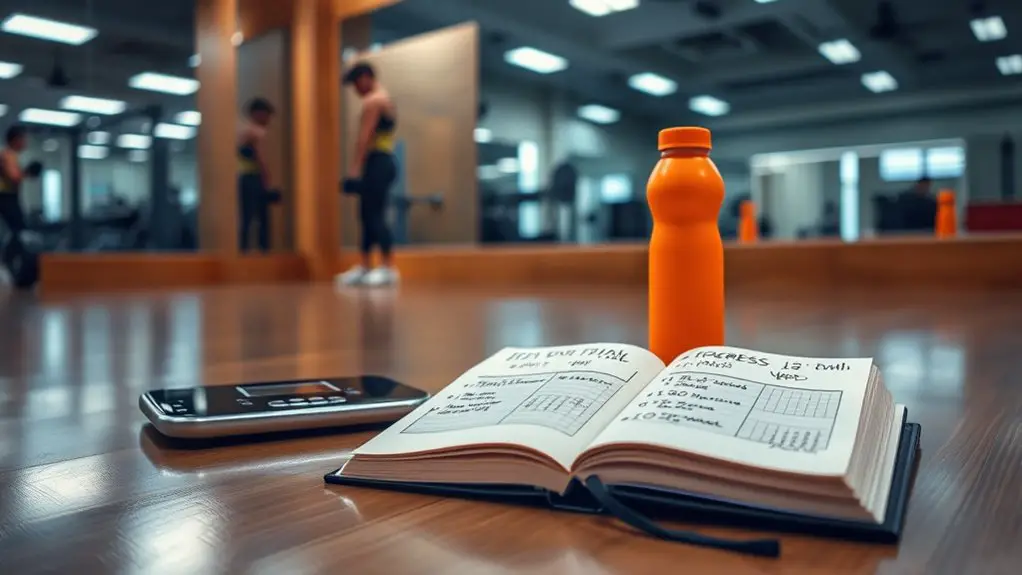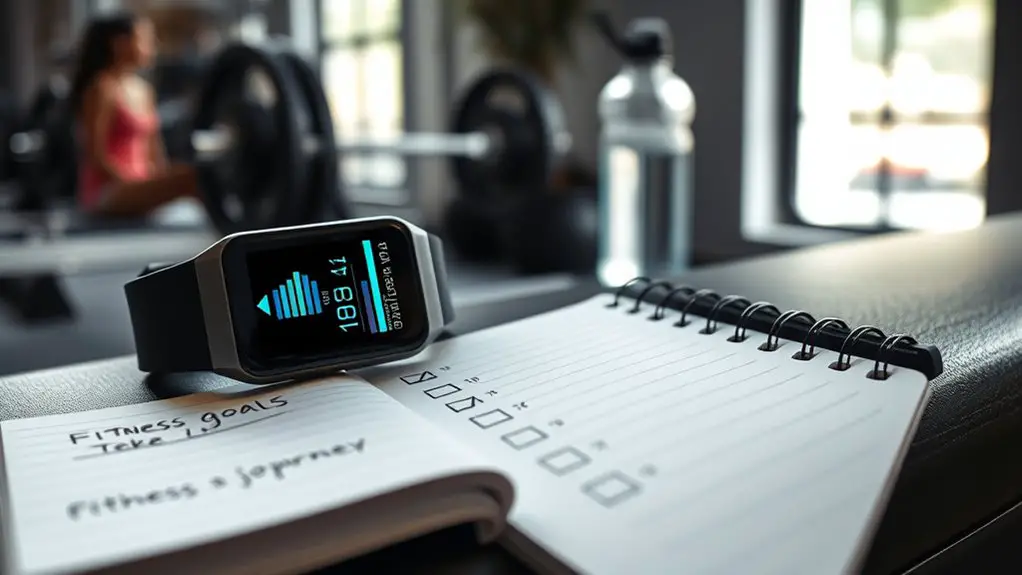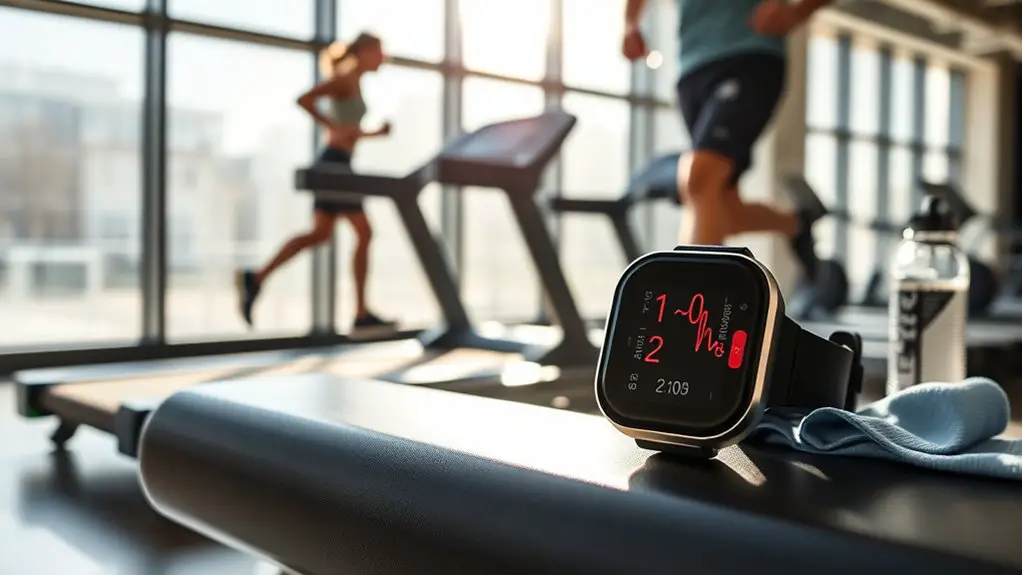How to Track Your Progress at the Gym

To track your progress at the gym, set clear fitness goals using SMART criteria. Keep a workout journal to log exercises, sets, reps, and your feelings during sessions. Monitor your weightlifting progress and cardio endurance by recording weight, heart rate, and workout duration. Use fitness apps or wearables for real-time feedback and community support. Don’t forget to take progress photos and measure your body composition regularly. This approach will keep you motivated and focused, and there’s more to discover ahead!
Setting Clear Fitness Goals

Setting clear fitness goals is essential for achieving success at the gym. Without defined targets, it’s easy to lose motivation or get sidetracked. Start with goal setting that follows the SMART criteria: Specific, Measurable, Achievable, Relevant, and Time-bound. For example, instead of saying, “I want to get fit,” specify, “I’ll run a 5K in three months.” This clarity helps you stay focused and reduces the risk of overexertion or injury.
When you set SMART goals, you’re creating a roadmap for your fitness journey. It not only helps you track progress but also guarantees your goals are realistic and aligned with your overall health. Remember, safety is key, so always listen to your body and adjust your goals as needed. By implementing effective goal setting, you’ll foster a positive mindset and pave the way for consistent improvement at the gym. Additionally, positive changes in body composition can serve as a motivating factor as you work towards your goals.
Utilizing a Workout Journal
Using a workout journal can be a game changer for your fitness journey. It helps you track key metrics like your workouts, progress, and goals, making it easier to see how far you’ve come. Plus, with a few tips for consistency, you’ll find it easier to stay motivated and on track.
Benefits of Journaling
One of the most effective ways to track your gym progress is by keeping a workout journal. The journaling benefits are numerous; it helps you stay organized and focused on your fitness goals. By documenting your workouts, you can identify patterns, recognize your achievements, and make informed adjustments to your routine. This process not only keeps you accountable but also provides a significant motivation boost. When you see how far you’ve come, it can inspire you to push through challenging days. Plus, reflecting on your entries can enhance your understanding of what works best for your body, keeping you safe and reducing the risk of injury. So grab a notebook, and start reaping the rewards of journaling today!
Key Metrics to Track
While tracking your progress at the gym, focusing on key metrics can make a significant difference in your journey. Start by incorporating strength assessments into your workout journal. Write down the weights you lift, the number of reps, and sets performed. This’ll help you identify improvements and guarantee you’re lifting safely to avoid injury.
Next, track your flexibility metrics. Note how far you can stretch or hold a pose during your warm-ups and cool-downs. Keeping a record of these measurements can motivate you to push your limits gradually. By regularly reviewing these metrics, you’ll gain valuable insights into your performance and overall fitness goals, allowing you to make informed adjustments to your routine for better results and safety.
Tips for Consistency
Tracking your progress is only part of the equation; staying consistent is just as important. A workout journal can help you maintain that consistency by keeping you accountable and focused on your goals. Here are some tips to make the most of your journal:
- Set clear goals: Define what you want to achieve with your workout routines.
- Record your workouts: Note exercises, sets, reps, and feelings after each session.
- Schedule regular check-ins: Review your progress weekly to stay motivated and adjust as needed.
- Involve accountability partners: Share your goals and progress with friends or workout buddies for support.
Tracking Weightlifting Progress
As you begin your weightlifting journey, keeping track of your progress is essential for staying motivated and achieving your goals. Start by recording the weight, sets, and reps for each exercise. This helps you identify effective weightlifting techniques and guarantees you’re practicing safely. Implementing progressive overload is key; gradually increase the weight or reps to challenge your muscles and stimulate growth.
Consider using a workout journal or a fitness app to log your workouts. Review your entries regularly to see how far you’ve come and adjust your routine as necessary. Don’t forget to note how you feel during each session—this can highlight any areas where you might need to focus on form or recovery. By tracking your weightlifting progress, you’ll not only stay motivated but also guarantee that you’re lifting safely and effectively, making consistent strides toward your fitness goals.
Monitoring Cardio Endurance

When it comes to monitoring your cardio endurance, tracking your workout duration is key. You should also measure your heart rate to see how your body responds over time. This way, you can clearly see improvements in your stamina and overall fitness. Additionally, incorporating activities like skipping rope can help elevate your heart rate and burn calories effectively.
Track Workout Duration
Measuring workout duration is essential for enhancing your cardio endurance. Keeping track of how long you exercise helps you set goals and monitor improvements safely. Use workout timers to record your sessions accurately. Consider incorporating interval training, alternating between high and low-intensity periods, which can boost endurance while also preventing overexertion.
Here are some tips for tracking workout duration:
- Set clear time goals for each session.
- Use a stopwatch or fitness app for accuracy.
- Log your workouts in a journal or app.
- Gradually increase duration as your endurance improves.
Measure Heart Rate
Monitoring your heart rate during workouts provides valuable insights into your cardio endurance. By regularly measuring your resting heart rate, you can gauge your fitness level. A lower resting heart rate often indicates improved cardiovascular health. During exercise, pay attention to your heart rate variability; this can signal how well your body is adapting to workouts. Aim to stay within your target heart rate zone to maximize benefits while ensuring safety. If you notice significant fluctuations or consistently high readings, it might be time to adjust your workout intensity or consult a healthcare professional. Remember, tracking these metrics helps you make informed decisions about your training and enhances your overall fitness journey. Stay safe and listen to your body!
Using Fitness Apps and Wearables
As you endeavor to reach your fitness goals, using fitness apps and wearables can be a game changer. These tools not only help you track your progress but also enhance your workout experience with various features. Here are some benefits you’ll find:
Utilizing fitness apps and wearables can revolutionize your journey towards achieving your fitness goals.
- Fitness app features like workout tracking, personalized plans, and nutrition logging can keep you organized and motivated.
- Wearable technology advantages such as heart rate monitoring and step counting provide real-time feedback on your performance.
- You can set reminders for workouts or hydration, ensuring you stay on track without overexerting yourself.
- Many apps offer community support, connecting you with others for motivation and accountability.
Taking Progress Photos

Taking progress photos is one of the most effective ways to visually document your fitness journey. By capturing your transformation, you can stay motivated and see how far you’ve come. To maximize the benefits, consider the following tips on photo frequency and lighting conditions:
| Photo Frequency | Lighting Conditions | Best Angles |
|---|---|---|
| Weekly | Natural light preferred | Front, side, and back |
| Bi-weekly | Consistent lighting | Eye level |
| Monthly | Avoid harsh shadows | Full-body shots |
Choose a consistent time and location for your photos to guarantee you’re comparing apples to apples. Natural light works best, so try to take your photos near a window or outdoors. Always prioritize your safety by using a tripod or stable surface to avoid accidents while taking these shots. Celebrate your progress, no matter how small!
Evaluating Body Measurements and Composition
While tracking your progress, evaluating body measurements and composition can provide a clearer picture of your fitness journey than weight alone. Focusing on body fat and muscle mass gives you a more thorough view of your health. Here are some key aspects to take into account:
- Body Fat Percentage: Measuring this helps you understand fat loss versus muscle gain.
- Circumference Measurements: Regularly measuring areas like your waist, hips, and arms can show changes in muscle and fat distribution.
- Skinfold Measurements: Using calipers can help track body fat changes accurately.
- Body Composition Analysis: Many gyms offer tools to assess muscle mass and body fat percentage, providing valuable insights.
Frequently Asked Questions
How Often Should I Reassess My Fitness Goals?
You know that feeling when you hit a milestone, and it’s like the universe is cheering you on? That’s what fitness is all about! It’s wise to reassess your fitness goals every 4-6 weeks. This gives you time to evaluate your progress against your goal timelines while ensuring you’re staying safe. Celebrate those fitness milestones, but don’t hesitate to adjust your goals as needed. Your journey is unique, and it’s all about you!
Can I Track Progress Without a Gym Membership?
Absolutely, you can track your progress without a gym membership! Home workouts can be just as effective. To keep an eye on your improvements, consider using fitness apps that track your workouts, reps, and overall performance. These tools often have built-in safety features, helping you stay injury-free. By regularly logging your routines and milestones, you’ll not only stay motivated but also see how far you’ve come in your fitness journey!
What Should I Do if I Hit a Plateau?
You’ve been pushing hard, but suddenly, it feels like you’re stuck—hitting a plateau can be frustrating. The causes can vary, from routine fatigue to not challenging your muscles enough. To overcome stagnation, consider mixing up your workouts or adjusting your diet. Don’t forget to rest; your body needs recovery time to grow stronger. With patience and a few tweaks, you’ll break through that barrier and keep progressing toward your goals.
How Do I Stay Motivated During My Fitness Journey?
Staying motivated during your fitness journey can be tough, but it’s important. Surround yourself with fitness buddies who share your goals; they’ll keep you accountable and make workouts more enjoyable. Try goal visualization, too—picture yourself achieving your targets and how great it feels. Remember to celebrate small victories along the way; they’ll boost your confidence. Finally, listen to your body and prioritize safety to guarantee a sustainable and fulfilling journey.
Is It Necessary to Track Every Workout Detail?
Did you know that tracking your workouts can boost your results by up to 30%? While it’s not necessary to document every detail, keeping a workout journal or using fitness apps can help you stay focused and safe. It’s all about finding what works for you. If you’re tracking the essentials—like weights, reps, and how you feel—you’ll gain valuable insights without feeling overwhelmed. Balance is key to a successful and safe fitness journey!





